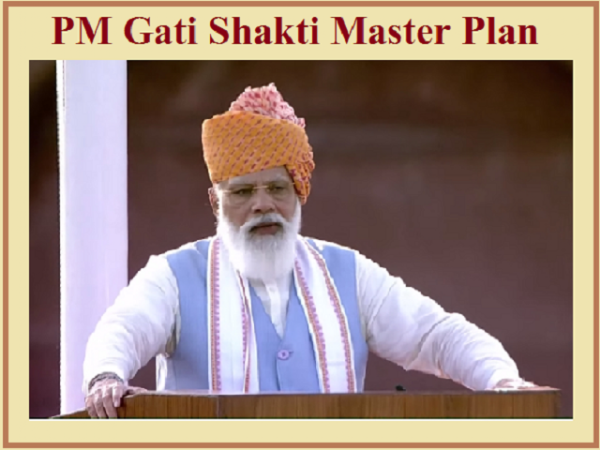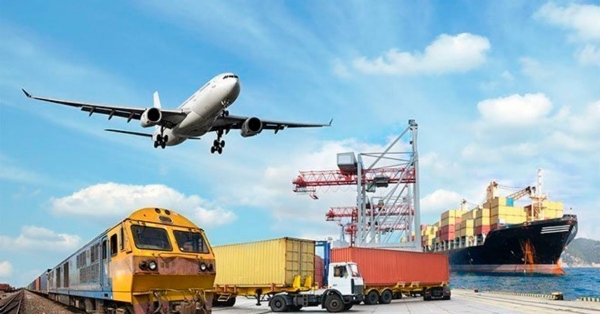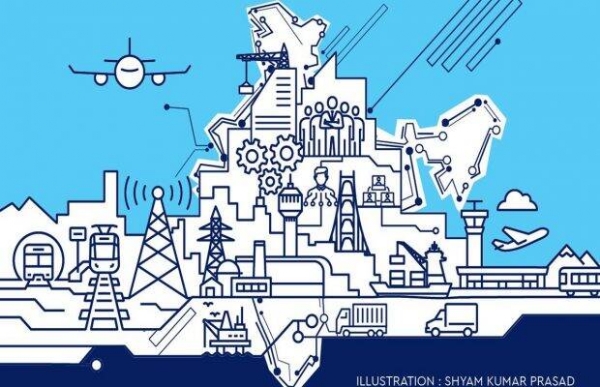Will PM Gati Shakti Drive India To Become The Business Capital Of The Globe?
Gati, the Hindi word for speed, aims to boost economic growth through infrastructure development (Shakti). It is recognised as the government"s all-encompassing strategy for developing modern railways, highways, canals, and airways.
Total Views |
On India's 75th Independence Day, Prime Minister Narendra Modi said that the government will launch the 'PM Gati Shakti Master Plan,' a Rs.100 lakh-crore project to build 'holistic infrastructure.' It's a national master plan for integrating connective infrastructure projects across modes of transportation, and it's anticipated to help India achieve its goal of becoming the "business capital" of the globe.

Gati Shakti Master Plan: What Is It?
Prime Minister Narendra Modi launched the PM Gati Shakti, a multi-modal connectivity "national masterplan" that is undoubtedly one of his most ambitious initiatives, as he tries to break down decades of bureaucratic entanglements and silos in infrastructure projects. The Gati Shakti master plan will use geo-mapping and real-time data on a single centralised platform to ensure that key agencies and governments are aware of major projects in the pipeline, particularly those with multi-sectoral and multi-regional impacts. Railways, Roads and Highways, Petroleum and Gas, Power, Telecom, Shipping, Aviation, and other central government departments would be involved in this effort.
Gati, the Hindi word for speed, aims to boost economic growth through infrastructure development (Shakti). In many of his recent remarks, Prime Minister Modi has mentioned the 'new international order.' The Gati Shakti mission is led by NICDC (national industrial corridor development corporation ltd). It will link industrial sectors in all states to Delhi, Mumbai, Bangalore, Chennai, Hyderabad, Visakhapatnam, and finally Chandigarh. It's similar to the post-World War II development plans in the United States and China three decades ago. It is expected to hire twice as many competent workers, triple exports, and quadruple currency. The North East is being included in this development mega drive alongside the rest of the country, with a focus on developing airports, goods trains, and dedicated freight corridors.
The comprehensive infrastructure development effort 'Gatishakti' aims to boost industry productivity and job opportunities. It is recognised as the government's all-encompassing strategy for developing modern railways, highways, canals, and airways.
This national master plan lays the foundation for the country's complete infrastructure as well as a comprehensive economic path. The Rs 100 trillion plan intends to develop road, rail, air, and waterway interconnection to reduce travel time and increase industrial output.
The Indian government's production-linked incentive is expected to increase demand for a range of other industries, such as cement, metals, and energy, while also creating jobs. It would also improve manufacturing's worldwide competitiveness.
Through road linkages, Gati Shakti will also provide opportunities for new future economic zones, reducing travel time and increasing industrial production. This investment project will aid the country's post-pandemic economy by increasing local technological output and decreasing reliance on other countries.
The rise in infrastructure spending is in line with the government's goals to boost infrastructure spending to assist economic growth.
The Gatishakti plan, according to Prime Minister Narendra Modi, will lay the groundwork for India's regeneration, allowing it to produce world-class products using cutting-edge technology and innovation.

The Gati Shakti Master Plan is Supported By The Following Six Pillars:
1. Comprehensiveness: Bringing all government initiatives together on a single platform to give data and visibility to all government agencies for successful planning.
2. Prioritization: Project priorities are determined through cross-sectoral collaboration.
3. Optimisation: In collaboration with the ministries, the project planning process will discover important stumbling blocks, allowing the ministries to design the best solutions.
4. Synchronization: Gati Shakti will assist in the holistic synchronisation of each department's activity in addition to ensuring cross-departmental collaboration.
5. Analytical: A GIS-based spatial planning and analysis tool will be included in the strategy. The executing agency will have consistent data in one location, providing for better visibility and decision-making.
6. Dynamic: All ministries and departments will be able to follow, assess, and visualise the progress of cross-sectoral projects using satellite images to fuel an integrated GIS platform.
At some ways, these are the same ideas at work in PM Modi's vision, Dholera SIR, which he hopes to use as an exemplary greenfield global smart city.
Gati Shakti - A Must
Modi remarked during the commencement of the Gati Shakti programme that challenges such as lack of coordination, lack of prior knowledge, and thinking and working in silos were causing construction delays and money loss due to the vast gap between macro planning and micro execution.
"One agency builds a new outstanding quality road, and then another department digs the same road to construct water pipelines a few days later," the PM added. A lack of cooperation of this magnitude must be addressed."
Individual ministries and departments usually operate in silos, resulting in delays in project planning and implementation due to a lack of collaboration. PM GatiShakti will help to synchronise the activity of each department, as well as many tiers of governance, by ensuring coordination.
While the government has not stated so, it is apparent that Gati Shakti will manage the majority of the key projects under the Rs 110 lakh billion National Infrastructure Pipeline.
Gati Shakti will comprise Bharatmala, Sagarmala, UDAN, inland waterways, dry/land ports, and other infrastructure initiatives of the Union and state governments. The plan will also ensure that the job is executed in a timely and cost-effective manner. The purpose is to bring together all of the necessary partners in order to quickly construct the proper scale infrastructure in the suitable location.
The master plan is expected to transform the infrastructure sector by ensuring integrated, seamless, and timely project delivery within budgeted costs, free of delays and cost overruns caused by multiple changes, and by encouraging private companies to partner with government projects, thereby boosting the Indian economy.

Gati Shakti's Objectives
1) A huge infrastructure programme, which Gati Shakti maintains, has been one of the Modi government's main objectives in the second term.
2) The plan targets for 11 industrial corridors, a Rs 1.7 lakh crore defence production turnover, 38 electronics manufacturing clusters, and 109 pharmaceutical clusters by 2024-25.
3) From 2024 to 2025, the national master plan establishes goals for all infrastructure ministries. The mission of the Road Transport and Roads Ministry is to construct 2 lakh kilometres of national highways, finish 5,590 kilometres of four- or six-lane highways along coastal areas, and connect all state capitals in the northeast with four-lane or two-lane highways.
4) By 2024-25, railways must handle 1,600 million tonnes of freight, up from 1,210 million tonnes in 2020, and decongest 51% of the network by adding new lines and establishing two Dedicated Freight Corridors (DFCs).
5) The plan is to double the current aviation footprint to 220 airports, heliports, and water aerodromes by 2025, which will necessitate the building of 109 new facilities. According to the national master plan, overall cargo capacity handled at ports will have expanded to 1,759 MMTPA by 2024-25, up from 1,282 MMTPA in 2020.
6) The country's gas pipeline network will be doubled to 34,500 kilometres by 2024-25, according to the proposal, with a 17,000-kilometer trunk pipeline connecting the industry's major demand and supply centres. By 2024-25, the total transmission network for electricity lines is estimated to reach 4.52 lakh circuit km, with renewable energy capacity increasing to 225 GW from the current 87.7 GW.
Expected Results
The map of existing and planned connecting initiatives will be aided by the strategy. Furthermore, there will be a lot of transparency regarding how the country's different regions and industrial centres are connected, especially in terms of last-mile connectivity.
A comprehensive and integrated transportation connection plan that includes all modes of transportation can greatly assist Make in India.
It will help India achieve its goal of becoming the world's business capital.
Gati Sakti-Related Concerns
1) Low Credit Acceptance: Despite the government's "significant" banking sector reforms and the Insolvency and Bankruptcy Code's recovery of around Rs. 2.4 lakh crore in bad loans, there are concerns about sliding credit offtake trends.
2) Banks offer credit off-takes to help businesses get funding for future projects by predicting future revenue and demonstrating the market's existence.
3) The scarcity of demand: In the post-Covid-19 environment, there is a scarcity of private and investor demand.
4) Structured Difficulties: Due to land acquisition delays and legal obstacles, project execution is exceptionally slow by worldwide standards. Obtaining licences for land access and environmental clearances is exceedingly difficult; also, current court litigation hampers infrastructure development.
Final Thoughts
Gati Shakti, PM Modi's initiative, is a positive step forward. It must, however, address structural and macroeconomic stability issues that have evolved as a result of overspending by the government. As a result, the success of this endeavour depends on a stable and predictable regulatory and institutional environment.


